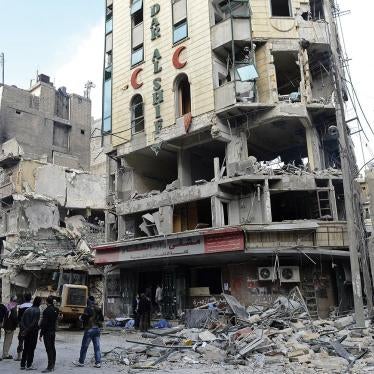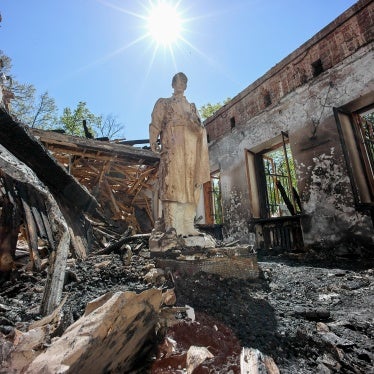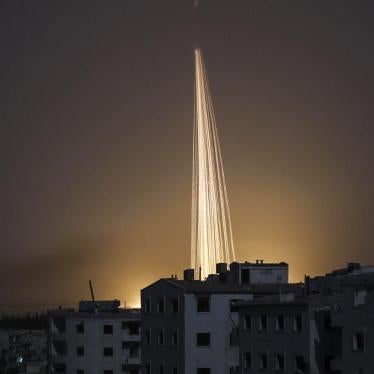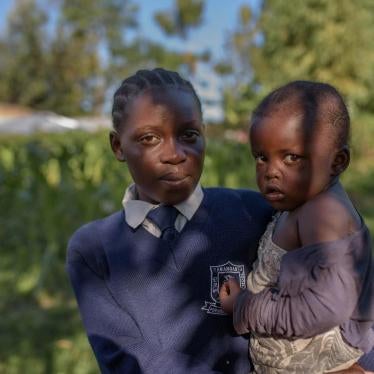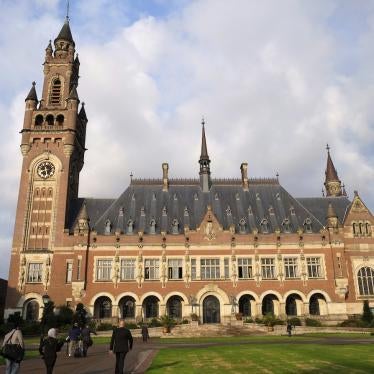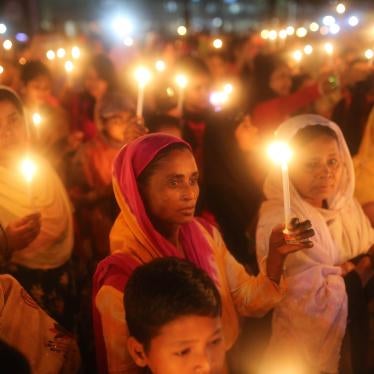(New York) – New Syrian government air and missile strikes are causing high civilian casualties in opposition-controlled areas of Aleppo in violation of the laws of war, Human Rights Watch said today. A Human Rights Watch team in northern Aleppo province has investigated recent attacks that killed scores of civilians and destroyed dozens of civilian homes without damaging any apparent opposition military targets.
The information collected by Human Rights Watch shows that the Syrian government continues to use banned cluster bombs and indiscriminate methods of attack in populated areas, making the airstrikes unlawful. These attacks are serious violations of international humanitarian law and the laws of war. Those who order or carry out such violations with criminal intent – that is, deliberately or recklessly – are responsible for war crimes.
“In attack after attack in Aleppo it is only civilians and civilian homes that are hit by government airstrikes,” said Anna Neistat, associate program and emergencies director at Human Rights Watch. “The Syrian Air Force knows very well that using cluster bombs and raining down missiles and bombs indiscriminately on urban areas violates the laws of war.”
During a recent seven-day mission to Aleppo, Human Rights Watch researchers documented five attacks that took place between March 18 and April 7, 2013:
- On April 7, an airstrike in the Ansari neighborhood of Aleppo killed at least 22 civilians, including 6 children.
- On April 3, a cluster bomb attack in the Sheik Sa’eed neighborhood of Aleppo killed 11 civilians, including 7 children.
- On March 29, a cluster bomb and ballistic missile attack in the town of Hreitan in northern Aleppo killed at least 8 civilians, including 2 children, and injured dozens more.
- On March 24, an airstrike in the town of Akhtarin in northern Aleppo killed 10 civilians, including at least 4 children.
- On March 18, an airstrike on Marjeh neighborhood in the city of Aleppo killed at least 33 civilians, including at least 17 children.
Human Rights Watch visited the site of each attack, interviewed witnesses, and, where possible, examined the remnants of the munitions used in the attack.
The recent attacks documented by Human Rights Watch follow the same pattern as the 59 attacks described in a recent report, “Death from the Skies: Deliberate and Indiscriminate Air Strikes on Civilians.” In its investigation of dozens of attacks in that report, Human Rights Watch concluded that Syrian forces used means and methods of warfare that under the circumstances could not distinguish between civilians and combatants, making attacks indiscriminate and therefore unlawful. Some attacks appeared to target civilians and civilian structures deliberately or did not target an apparent military objective.
In three of the recent strikes documented by Human Rights Watch, researchers found that there were Free Syrian Army bases, which are likely military targets, in the neighborhoods, but that none of the airstrikes affected them.
In Akhtarin and Hreitan, the nearest opposition military base was several kilometers away from the strike, and witnesses said that no opposition fighters were in the neighborhood at the time of the strike. In Sheik Sa’eed and Hreitan, government forces used cluster bombs– which most nations have banned because of their indiscriminate nature. Human Rights Watch has previously documented government use of more than 150 cluster bombs in 119 locations.
In all the new cases, witnesses told Human Rights Watch that the only people killed or injured by the strikes had been civilians, and that only civilian buildings had been hit. A casualty database compiled by the Violations Documentation Center (VDC), a Syrian monitoring group working in coordination with a network of Syrian opposition activists, also lists only civilians among the casualties.
The obligation to minimize harm to the civilian population applies to all parties to a conflict. The Free Syrian Army (FSA) and other Syrian armed opposition groups should take all feasible measures to avoid deploying forces and military structures such as bases or headquarters in or near densely populated areas. However, an attacking party is not relieved of the obligation to take into account the risk to civilians from an attack on the grounds that the defending party has located military targets within or near populated areas.
The attacks documented by Human Rights Watch represent a small fraction of the total number of air and missile strikes by government forces in the last month. According to VDC casualty lists, there were almost daily airstrikes, resulting in at least 355 civilian casualties from March 18 to April 22. The VDC does not compile separate statistics for missile strikes, but during a mission to Syria in February, Human Rights Watch documented four missile strikes that month that killed more than 140 civilians, approximately half of them children.
“Governments that claim to support human rights should make it clear that Syria’s indiscriminate airstrikes on its own people need to end,” Neistat said. “They must ensure that those responsible for these crimes are brought to justice and that means referring Syria to the International Criminal Court now.”
New Aleppo Air and Missile Strikes
Human Rights Watch documented five air and missile strikes by Syrian government forces that took place between March 18 and April 7 in the city of Aleppo and in Aleppo province. The conclusions that follow are based on investigations that include interviews with victims, witnesses, and opposition officials and combatants.
Human Rights Watch also visited the site of each of the attacks and examined the fragments of munitions used in attacks. Human Rights Watch corroborated casualty figures with databases complied by the Violations Documentation Center (VDC) and analyzed videos posted on YouTube video, and photographs to corroborate the statements to Human Rights Watch by witnesses.
April 7 Airstrike on Ansari Neighborhood, Aleppo City
Around 11 a.m. on April 7, a jet dropped four bombs, killing at least 22 civilians, including at least six children, in the Ansari neighborhood in Aleppo city. “Aziza,” 12, told Human Rights Watch that she had just arrived at her grandparents’ apartment with her family when she heard the sound of a jet and then a huge explosion:
Suddenly, it was all covered in dust. I heard my aunt screaming; she was calling for survivors, and then some men took me and my little sister out of the rubble. The wall and stairs were gone. They handed us over one to the other.
The attack killed her mother, twin brother and two other close relatives, and seriously injured her father, she said. Aziza and her 6-year-old sister survived only because they were playing in one of the interior rooms.
One witness who arrived on the scene shortly after the attack told Human Rights Watch:
This area is far away from the front lines. One bomb hit the road, and the others struck the houses. When we arrived at the scene, there was thick dust everywhere. We couldn’t see. My friend stepped on a corpse in the street because he couldn’t see. One home was on fire, so they brought a fire truck. It was very difficult to get the wounded out of the rubble, and some died because we were too late.
When Human Rights Watch visited the attack site on April 9, local residents were clearing the rubble from two seven-story residential buildings that had been completely destroyed in the attack. Large slabs of the roof and floors were hanging where the buildings once stood, kept in place only by the steel reinforcing bars in the concrete.
Witnesses said that government forces dropped the four bombs that struck the area using parachutes. One of the neighbors, a man in his 30’s, told Human Rights Watch:
I was sitting on my balcony when I saw the plane. When I saw the bomb with the parachute, I ran inside. My whole family was there. I have three daughters and one son. When the bomb exploded, the pressure lifted me up and threw me against the wall.
Human Rights Watch examined the remnants of one parachute and at least two of the bombs, which had been collected by a local armed opposition group. Nic R. Jenzen-Jones, a military arms and munitions specialist, identified one of the remnants as belonging to an AVU-529 (АВУ-529) aviation bomb fuze, which is used with the OFAB-250ShN fragmentation bomb, according to Jenzen-Jones and weapons manuals.
During its visit, Human Rights Watch identified a building about 200 meters away that was occupied by a local armed group. This building was undamaged in the attack.
Witnesses said that what appeared to be the same plane struck again shortly thereafter with cluster bombs in the nearby Al-Amriyeh neighborhood. Human Rights Watch examined two unexploded cluster bomblets that a local armed opposition group said they had collected at the site, and reviewed photos of two cluster munition canisters, but was not able to visit the attack site. The dud submunitions bore the mark PTAB 2.5M in Russian, indicating that they were high explosive anti-armor cluster munitions.
Witnesses interviewed by Human Rights Watch said that no opposition fighters were among the casualties. This information is consistent with the VDC casualty database, which lists all casualties as civilian.
April 3 Cluster Bomb Attack on Sheik Sa`eed Neighborhood, Aleppo City
Just before noon on April 3, a jet dropped six cluster bombs on the Sheik Sa`eed neighborhood in Aleppo city, killing 11 civilians, including at least 7 children, and injuring many more.
“Mahmoud,” a local resident who was sitting on the roof with several members of his family at the time of the attack, told Human Rights Watch on April 9:
Suddenly the jet came and dropped its bombs. The bombs fell from above, one after another, small bombs spread out in the sky. They were exploding everywhere, like a volcano erupting, on and on. Shrapnel hit me in my behind and back. I was taken to the hospital which was full of wounded people, many in critical condition.
Mahmoud and his mother showed Human Rights Watch shrapnel from the attack and said that a local armed group had collected six cluster bomb canisters from the attack. Human Rights Watch was not able to inspect the remnants of the bombs.
Local residents said that a building used by an armed opposition group about 100 meters away could have been the target. The attack site is located on the southern side of city, not far from ongoing fighting between government and opposition forces. The building used by the armed opposition group appears to have been a legitimate military target, but the use of cluster bombs was unlawful because of their indiscriminate effect in a populated area.
Witnesses told Human Rights Watch that there were no opposition fighters among the casualties, and that opposition fighters were not in the area at the time of the attack. This information is consistent with the VDC casualty database, which lists all casualties as civilian.
March 29 Cluster Bomb and Ballistic Missile Attack on Hreitan, Northern Aleppo
On March 29, government forces attacked Hreitan, a town of about 40,000 people 10 kilometers north of the city of Aleppo.
Witnesses told Human Rights Watch that a jet first dropped a bomb in the northern part of the town. Shortly thereafter, the jet returned and dropped cluster bombs about 200 meters from the first attack site, injuring about 30 people. And then, shortly after 2 p.m., a ballistic missile struck, killing at least eight people, including two children. The attacks damaged at least nine houses and a mosque. VDC recorded 20 civilian casualties from the attack, but has names for only nine.
One witness to the attacks told Human Rights Watch on March 31:
I was just leaving the mosque in the northern part of town when we heard the sound from a jet followed by an explosion. After a couple of minutes, the jet came back and dropped several bombs, about 200 meters away from the first attack site. I went to the site and helped wounded people into an ambulance. I took an 8-year-old boy and his father to the hospital.
While we were in the hospital, I heard another large explosion. When we went to the last attack site, we found many killed and injured people under the rubble.
People who were present during the attack or who came to the rescue immediately after said that the nearest building used by opposition fighters was about three kilometers away, and that there was no fighting or any other military activity in the town at the time of the attack.
Local activists near Damascus reported several launches of ballistic missile heading north on March 29, including one shortly after 2 p.m., which is consistent with information provided by witnesses.
Witnesses interviewed by Human Rights Watch said that there were no opposition fighters among the casualties, and that no opposition fighters were in the area at the time of the attack. This information is consistent with the VDC casualty database, which lists all casualties as civilian.
March 24 Airstrike on Akhtarin, Northern Aleppo
On March 24, an air strike on the town of Akhtarin, about 35 kilometers north of the city of Aleppo, killed 10 civilians, including at least 4 children. Seven were from the same family.
The March 24 attack site is about 100 meters from three buildings that a government jet struck on November 7, 2012, killing seven civilians, including five children.
An armed opposition group had used a building 50 meters from the attack site, but local residents said they had abandoned it six months ago. When Human Rights Watch visited Akhtarin on April 9, the building that opposition fighters had previously used looked abandoned. The building also looked abandoned when Human Rights Watch visited the area in December. Local residents said that the group moved out of the town after the November 7 attack and that the closest opposition base was about two kilometers outside the town.
Witnesses said that there were no Free Syrian Army fighters in the area at the time of the attack, and that no fighters were killed in the attack. The VDC casualty figures for the attack also list 10 civilian casualties and no casualties of opposition fighters.
March 18 Airstrike on Marjeh Neighborhood, Aleppo
On March 18, a jet dropped six bombs on Marjeh neighborhood in the city of Aleppo, killing at least 33 civilians, including 17 children, injuring many more, and completely destroying about 40 houses, according to witnesses.
Witnesses told Human Rights Watch that at about 5 p.m., the jet conducted two consecutive attacks, dropping first two and then another four bombs, all with parachutes. “Ahmed,” who said that six children and three women from his extended family died in the attack, told Human Rights Watch:
I was inside the house, sorting clothes for sale. We heard the jet, but did not try to hide; we thought it would target the school where the FSA has its base, several hundred meters away from here. We stepped out to look, and at that moment the bombs fell, almost all of them at once. The explosion was huge – I was thrown back into the house. I was unharmed, but nine of my relatives were killed and another nine wounded. Five houses that belonged to our family were completely destroyed.
Another witness, who confirmed the account to Human Rights Watch, said that he lost his entire family, 19 people, in the attack, and that the attack completely destroyed his family home.
Witnesses provided Human Rights Watch with the names of 33 victims; a VDC list contains the names of 42 victims.
Witnesses interviewed by Human Rights Watch said that no opposition fighters were among the casualties, and that no fighters were in the area at the time of the attack. This information is consistent with the VDC casualty database, which lists all casualties as civilian.
Human Rights Watch examined the massive destruction caused by the strike, and confirmed that the school building used by the Free Syrian Army about 200 meters away was undamaged.
